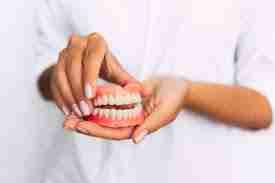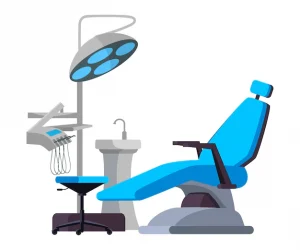Implant Dentures and Traditional Removable Dentures are the two most popular replacement options to restore missing teeth today.
These devices are similar and different at the same time. Because each patient has specific needs and oral conditions, a general evaluation with your dentist or prosthodontist will help you decide which is best for you.
What Are Implant Dentures and How Do they Work?

In general, Implant Dentures are anchored to 4 dental implants, which function as artificial tooth roots. This means they become part of the patient’s bone beneath the gum and serve as a firm basis for the false teeth to hold on to.
Fixed dentures will not only restore the appearance of your teeth and smile, but also the function of your whole mouth.
Today, fixed implant dentures are a successful surgical option to restore teeth, aesthetics and functionality.
What is the Difference Between Conventional and Implant Dentures?
Fixed or Implant Dentures are a set of false teeth that will allow you to eat, speak and live in a confident way. While conventional dentures may sometimes slip or be uncomfortable, fixed dentures use dental implants to guarantee this does not happen.
Conventional and fixed dentures have, as a starting point, the same goal: that the patient can eat and smile again. Traditional removable dentures have long been a solution for patients with missing teeth, but now there are more advanced and modern options.
There are many differences regarding Traditional and Implant Dentures. These are some of the most important ones:
Conventional Dentures:

- They are·used to replace missing teeth.
- They restore appearance, chewing and speaking.
- They do not last forever. As jaw changes its shape, dentures need to be replaced.
- They are used during the day and stored in cleaning solution at night.
- ·Patient needs to avoid certain foods to ensure dentures last longer.

Fixed Dentures:
- ·They are used to replace missing teeth.
- ·They restore appearance, chewing, speaking and FUNCTION.
- ·You can prevent bone deterioration by having implants attached to your dentures.
- ·They have similar strength and function as natural teeth.
- ·You can eat everything, as if you had natural teeth.
- ·As there is no bone reabsorption, jaw will not change its shape and dentures will continue to fit, in most cases, during a lifetime.
How Do I Know if I Need Implant Dentures?
This is why it is advisable to see a Prosthodontist to inquire about fixed dentures.
- Your smile has changed due to missing teeth.
- You feel your dentures are loose or uncomfortable.
- Your conventional dentures are affecting your quality of life.
- You have tooth loss or severe periodontal disease.
- You are experiencing loss of jawbone as a result of your loss of teeth.
If you are going through one or some of these situations, don’t wait long to contact your dentist.
How Can Dentures Improve my Smile?

Implant dentures are made to look completely natural. They are created with great care to function similarly to natural teeth.
It is for this reason you can feel relaxed and sure that when you talk, smile and even laugh, nobody will notice you are wearing dentures.
How Much do Fixed Dentures Cost?
Dentures are not inexpensive. Their price will depend on the material used, on the type of denture, and even on the prosthodontist you choose. This last is an important factor. If you are thinking of having dentures, always go for well-trained, specialized and serious prosthodontists.
Moreover, fixed dentures are more expensive than conventional dentures.
However, take this into account before deciding:
- Conventional dentures are prone to eventual wear and tear.
- When this happens, they become uncomfortable.
- If they are not repaired, you will not be able to eat properly.
So, think in the long term before making a decision.
What Should I Expect During the Denture Fitting Process?
The denture fitting process can take a while. There are certain steps to be followed and it requires considerable healing time.
This is what the process looks like:

Step 1: A Comprehensive Exam
The first step in this process is a visit to your prosthodontist. After a conversation, the specialist will give you detailed information about what is going on in your mouth and will tell you if you are a candidate for fixed dentures, or not.
Use this opportunity to ask any questions you may have about the treatment.
Step 2: X-Rays or CT Scan
To assess the general condition of your mouth and jaw, your dentist will take X-rays.
If the doctor considers that a regular x-ray procedure is not enough, you may need a dental CT Scan. This is a Computer Tomography Scan used to get high quality and more detailed images of your mouth and jaw.
With these images, your dentist can make a deeper evaluation and analyze the location of bone, sinuses and nerves. This will help to determine how many implants you will need and their exact position.
Step 3: Bone Grafting
A CT Scan will show if you need a bone graft. In some occasions, when a person has been edentulous for a long time, there can be a decrease in the bone mass. If there is less bone, it is possible that the implants will not attach properly.
Your dentist will need to restore your bone mass before placing a dental implant. He or she needs to apply bone tissue in those areas where bone loss has occurred. This bone tissue can be taken from the patient’s body, or a synthetic material can be used to fulfill the same purpose.
The tissue will add volume to the jaw and will also help the production of new bone, which will finally allow for the placement of dental implants.
Step 4: Implant Placement
Once the bone is ready, it’s time to place the implant.
Dental implants are titanium posts that replace the roots of teeth. This material is used for its ability to fuse to the bone in a process called osseointegration.
Implants are inserted into the jawbone by means of a screw-like device. The dentist will drill out the space where the implant needs to be inserted.
During this process, which lasts around 3 hours, the patient should not feel any pain. Local anesthesia is generally used, but some patients prefer to be put under.
Step 5: Temporary Dentures
After the dentist has finished inserting the implants, the patient can go home with already existing dentures or new temporary dentures for around three months.
This will give time to your jawbone to heal properly. During this time, it is important to avoid hard or crunchy foods that may generate unwanted pressure to the new implants.
Step 6: Your Permanent Dentures
After some three to six months have passed, and once the osseointegration has completed, your prosthodontist will placeyour permanent dentures.
This is done after the gum tissues have healed and there little risk of implant movement or failure.
With fixed dentures, you will leave the dental office feeling as if you had natural teeth. You should be able to eat anything you want, and enjoy a beautiful smile again.
So, once your denture treatment is completed, you should take care of your new teeth in the same way you look after natural teeth. Daily flossing and brushing is recommmended, and regular examinations with your dentist.
To decide which type of denture is best for you, don’t wait too long for a consultation with your prosthodontist or dentist. You can get a new smile again.